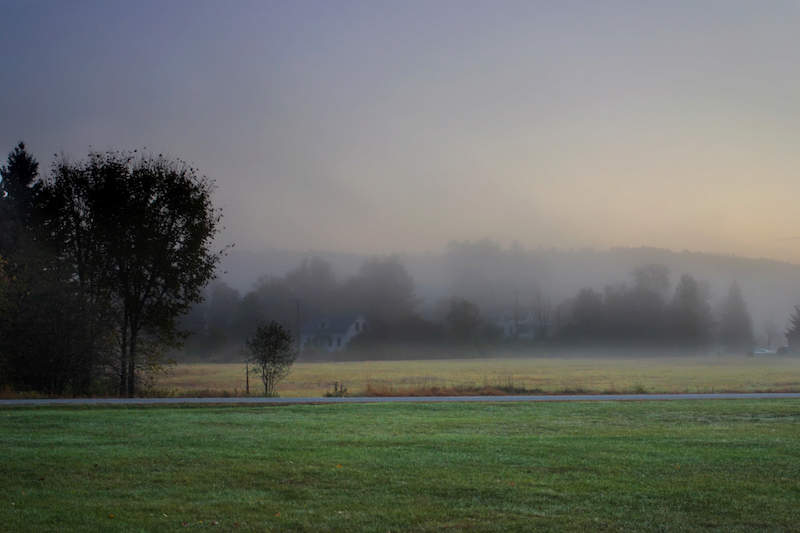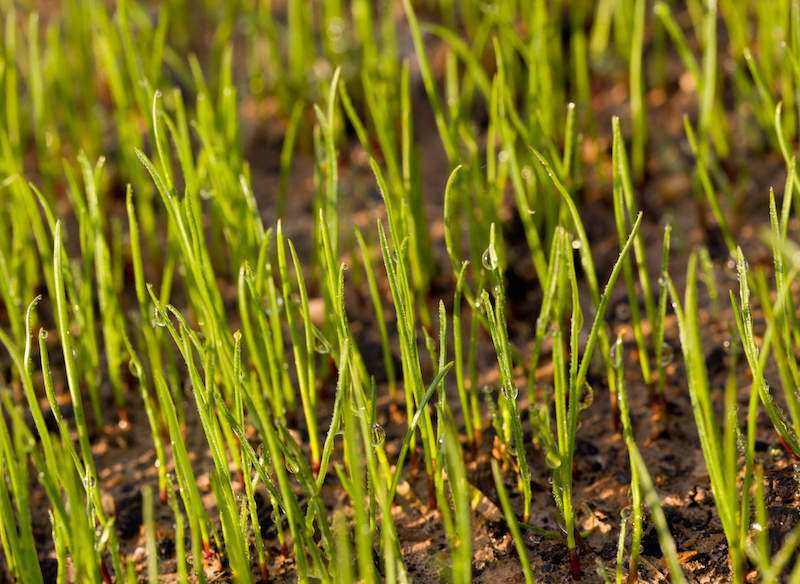All You Need to Know About Northeast Grass Mix
The cool, humid climate of the American Northeast is tough on plants, including lawn grasses. For lawns to thrive and look beautiful year after year, it takes more than just ordinary grasses. The Northeast's cold, long winters and disease-provoking dampness call for superior grass seed varieties bred and mixed specifically to meet the region's rigors. From Maine to Maryland, choosing a premium grass mix designed to meet the region's challenges can help you achieve a thicker, lusher, superior Northeast lawn.
Fast Facts for Northeast Needs
- Mix of superior cool-season grass varieties
- Suitable for cool, humid Northeast conditions
- Improved cold tolerance
- Improved drought and disease resistance
- Complementary growth habits for thick, lush lawns

The cool, humid climate of the Northeast calls for superior grass seed.
Best Grass Types for the Northeast
The Northeast's cold winters and moderate summers suit cool-season lawn grasses, but that's not the only consideration in choosing grasses for Northeast lawns. Parts of the region vary dramatically in moisture levels, soil pH, natural fertility, humidity and conditions that encourage lawn disease. Versatility and adaptability are essential qualities for grasses to excel in Northeast conditions.
By choosing a seed mix that combines premium varieties of different grass species, such as Pennington Smart Seed Northeast Mix, you can create an adaptable, resilient lawn that thrives in sunny to moderately shady areas. Improved, purebred grass seed varieties developed through Pennington research deliver superior performance — from improved drought tolerance to increased resistance to disease and common lawn-damaging pests [Link to upcoming Pennington/GardenTech story on Lawn Pests]. It's an ideal mix for lawns in the following Northeast states:
- Maine
- Rhode Island
- New Jersey
- Vermont
- Connecticut
- Maryland
- New Hampshire
- New York
- Delaware
- Massachusetts
- Pennsylvania

A short growing season requires Northeast grasses to establish quickly.
Perennial ryegrass in Pennington's Smart Seed Northeast Mix excels in cool, humid Northeast conditions. Perennial ryegrass germinates faster than any other common lawn grass — even in cool, damp soils — bringing your lawn quick color and stability. This is especially important for the Northeast, where spring starts late and winter comes early. Improved Pennington Smart Seed varieties add greater heat and drought tolerance than ordinary grasses and use up to 30 percent less water year after year, keeping your lawn healthy and looking good through summer months, too.
Kentucky bluegrass, often referred to as KBG, provides a perfect complement for perennial ryegrass in Pennington's Smart Seed Northeast Mix. KBG takes longer to germinate and get established, but this grass offers greater cold hardiness than any other common lawn grass. Combine that cold tolerance with KBG's dense, vigorous growth and the superior drought tolerance of Pennington Smart Seed varieties, and you have a rich, green lawn that's ready for Northeast winters and summers.
For added versatility and shade tolerance, fine fescues finish out an ideal Northeast lawn seed mix. The most shade-tolerant of all common lawn grasses, fine fescues add attractive color and a fine, pleasing texture. With a blend of upright fine fescue, such as Chewings fescue, and low-growing fine fescue, such as creeping red, your Northeast lawn benefits from improved shade tolerance, cold resistance and durability.

Northeast lawn grasses must be able to withstand extended cold and snow.
Northeast Lawn Care Calendar
The cool-season grasses in Pennington Smart Seed Northeast Mix hit their peak growth periods during the cool fall and spring seasons, then slow down or go dormant during summer months. To keep your lawn looking and performing its best, time Northeast lawn care tasks to complement these natural seasonal cycles.
Remember, the farther inland or north you live, the later spring conditions arrive and the earlier fall tasks begin. Weather conditions can vary significantly from year to year, so let your lawn be your guide. If you're unsure about typical frost and thaw cycles for your local area, check with your county extension agent. Then follow this Northeast lawn care calendar for a beautiful, lush Northeast lawn.
MARCH THROUGH MAY
Mowing
Start mowing as soon as your grass starts growing. Mow to maintain your Northeast lawn at 2 to 3 inches tall. The first time out, mow slightly lower than normal and bag your clippings. This helps discourage the spread of winter fungal disease such as snow mold.
Weed Prevention and Fertilization
Prevent crabgrass and feed your established Northeast lawn in early spring with Pennington Full Season Weed & Feed with Crabgrass Control 25-0-8. Apply this preemergent before weed seeds germinate, which starts when soil temperatures hit 55°F. In the Northeast, that's the same time as when yellow forsythia bushes typically bloom. Do not apply preemergent herbicide to seeded or overseeded areas within 60 days after seeding.
Seeding and Overseeding
Next to early fall, early spring is the second best time to plant grass seed in cool Northeast lawns. Cool-season grasses in Pennington Smart Seed Northeast Mix germinate best when soil temperatures range between 50°F and 65°F. Daytime air temperatures are usually around 60°F to 75°F at that time. If you're seeding in spring, avoid crabgrass preventers and weed & feed products. Use Pennington Full Season Lawn Fertilizer 32-0-5 to help newly seeded areas get started right.
Fix bare and brown Northeast lawn spots with Pennington Smart Patch II Sun & Shade Mix. Used as directed under correct conditions and you'll see growth in as little as 5 days and full results as soon as 14 days. This premixed product combines Pennington Smart Seed, professional fertilizer and natural mulch all in one.
Weed Control and Fertilization
To target emerged broadleaf weeds in your established Northeast lawns, wait until grass and weeds are in active, late-spring growth and then apply Pennington Full Season Weed & Feed with Crabgrass Control 25-0-8. Do not apply post-emergent herbicide to newly seeded areas until new grass is established and you mow at least three times. After application, wait at least three weeks before reseeding.
Watering
Water your established Northeast lawn so that it receives about 1 inch of water per week, including rainfall. Deep, thorough irrigation encourages deep root growth.
JUNE THROUGH AUGUST
Mowing
Increase your mowing height to 3 to 4 inches tall to help your Northeast lawn withstand summer stresses. Mow often enough so you never remove more than one-third of the blade at any one time.
Fertilization
Fertilize your summer lawn with a split application of Pennington Full Season Lawn Fertilizer 32-0-5. The added iron helps keep Northeast lawns green.
Watering
Water as needed so your established Northeast lawn gets 1 to 1 1/4 inches of weekly water from irrigation and rainfall combined.
Pest Control
Treat lawn pests such as grubs and chinch bugs with Sevin Insect Killer Lawn Granules before they can cause extensive damage or reproduce.
Soil Testing
Test your lawn soil every three to four years to confirm your soil pH. Cool-season grasses in Pennington Smart Seed Northeast Mix do best when soil pH stays between 5.8 to 7.0. Most Northeast soils are naturally acidic. A test lets you know if your lawn needs lime to raise soil pH.
SEPTEMBER THROUGH NOVEMBER
Mowing
Gradually decrease your mowing height to 2 to 3 inches as temperatures cool. Keep mowing until your lawn stops growing. Then do one final, slightly lower prewinter mow.
Weed Control and Fertilization
Treat broadleaf weeds and fertilize with a fall application of Pennington Full Season Weed & Feed with Crabgrass Control 25-0-8 six to eight weeks before your first expected frost. If you're overseeding, skip weed and feed and use Pennington Full Season Lawn Fertilizer 32-0-5 and spot-treat stubborn lawn weeds instead.
Early fall is the ideal time to seed or overseed your Northeast lawn. Plant Pennington Smart Seed Northeast Mix about 45 days before your typical first fall frost date so it gets established before winter comes.
Watering
Gradually reduce watering from 1 inch of water per week to 1 inch every 10 to 14 days.
Aeration and Dethatching
Aerate and dethatch, if needed, to reduce soil compaction and excess thatch. The Northeast's low soil pH can encourage thatch problems. Fall timing supports fast recovery.
Leaf Management
Manage fallen leaves by raking or mulching so your Northeast lawn enters winter free of leaf cover.
DECEMBER THROUGH FEBRUARY
Yard Patrol
Keep your Northeast lawn free of winter debris, such as stick and rocks, so you're ready when spring comes.
Tool Maintenance
Sharpen mowers and clean turf tools to lessen risks of lawn disease from year to year and be ready for an early spring.
Late-Winter Flush
In late winter, as your lawn thaws, flush areas with known de-icing salt or pet urine damage. This helps prepare your lawn for spring repairs.
By giving your Northeast lawn a foundation of premium grass seed varieties specifically suited to the region's unique challenges, you can enjoy a thicker, lusher lawn for years to come. Pennington has been cultivating the trust of homeowners and lawn professionals for three generations by growing the finest grass seed possible. With Pennington Smart Seed Northeast Mix, you benefit from better research, better seed and better results — guaranteed.
Always read product labels thoroughly and follow instructions.
Pennington, One Step Complete and Smart Seed are registered trademarks of Pennington Seed, Inc.
UltraGreen is a registered trademark of Central Garden & Pet Company.
Sevin is a registered trademark of Tessenderlo Kerley, Inc.


